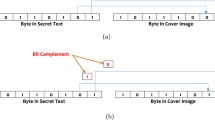Abstract
Internet of things (IoT) realizes the concept of bringing things connected together. Data are exchanged and controlled within one or more IoT networks. Sensitive data transferred between different IoT networks may also lead to data leakage. One way to reduce the risk of these problems is to employ steganography while delivering secret information over the IoT networks. This paper presents a steganographic scheme that employs vector quantization (VQ) transformation and the least significant bits (LSB) to embed secret data into a cover image. We devise a new technique, namely two-level encoding, to separate the pixels of a \(4\times 4\) VQ-transformed image block into two groups, the LSB group and the secret data group, in the first level. Then we use an indirect approach that embeds VQ indexes in the LSB group and secret data in the secret data group in the second level. The embedded VQ indexes are used to represent the VQ-transformed image blocks, and the secret data are used as the difference values to adjust the VQ-transformed image blocks and to create stego-image blocks, such that the stego-image blocks become more similar to the original image blocks after embedding. Compared with other similar work, the experimental results show that the proposed scheme produces stego-images with slightly better quality in terms of PSNR; the experimental results also indicate that it provides about ten times as large as the embedding capacity of the prior similar schemes. Moreover, the proposed scheme is able to pass the popular detections, such as Chi-square test and AUMP LSB, both to detect whether an image uses LSB for data hiding.








Similar content being viewed by others
References
Yang CH, Weng CY, Wang SJ, Sun HM (2008) Adaptive data hiding in edge areas of images with spatial LSB domain systems. IEEE Trans Inf Forensics Secur 3(3):488–497
Yang CH, Weng CY, Wang SJ, Sun HM (2010) Varied PVD + LSB evading detection programs to spatial domain in data embedding systems. J Syst Softw 83(10):1635–1643
Luo W, Huang F, Huang J (2010) Edge adaptive image steganography based on LSB matching revisited. IEEE Trans Inf Forensics Secur 5(2):201–214
Liao X, Wen QY, Zhang J (2011) A steganographic method for digital images with four-pixel differencing and modified LSB substitution. J Vis Commun Image Represent 22(1):1–8
Chang CC, Tai WL, Lin CC (2006) A reversible data hiding scheme based on side match vector quantization. IEEE Trans Circuits Syst Video Technol 16(10):1301–1308
Chen LS, Lin JC (2010) Steganography scheme based on side match vector quantization. Opt Eng 49(3):0370081–0370087
Huang CT, Wang WJ, Yang CH, Wang SJ (2013) A scheme of reversible information hiding based on SMVQ. Imaging Sci J 61(2):195–203
Wang ZH, Chang CC, Chen KN, Li MC (2010) An encoding method for both image compression and data lossless information hiding. J Syst Softw 83(11):2073–2082
Yang CH, Wang WJ, Huang CT, Wang SJ (2011) Reversible steganography based on side match and hit pattern for VQ-compressed images. Inf Sci 181(11):2218–2230
Shen JJ, Ren JM (2010) A robust associative watermarking technique based on vector quantization. Digit Signal Process 20(5):1408–1423
Lu ZM, Wang JX, Liu BB (2009) An improved lossless data hiding scheme based on image VQ-index residual value coding. J Syst Softw 82(6):1016–1024
Lin CC, Chen SC, Hsueh NL (2009) Adaptive embedding techniques for VQ-compressed images. Inf Sci 179(1–2):140–149
Wang JX, Lu ZM (2009) A path optional lossless data hiding scheme based on VQ joint neighboring coding. Inf Sci 179(19):3332–3348
Lee CC, Ku WH, Huang SY (2009) A new steganographic scheme based on vector quantisation and search-order coding. IET Image Process 3(4):243–248
Chen WJ, Huang WT (2009) VQ indexes compression and information hiding using hybrid lossless index coding. Digit Signal Process 19(3):433–443
Lee CF, Chen HL, Lai SH (2010) An adaptive data hiding scheme with high embedding capacity and visual image quality based on SMVQ prediction through classification codebooks. Image Vis Comput 28(8):1293–1302
Lee Y, Kim H, Park Y (2009) A new data hiding scheme for binary image authentication with small image distortion. Inf Sci 179(22):3866–3884
Patra JC, Phua JE, Bornand C (2010) A novel DCT domain CRT-based watermarking scheme for image authentication surviving JPEG compression. Digit Signal Process 20(6):1597–1611
Phan RCW (2008) Tampering with a watermarking-based image authentication scheme. Pattern Recognit 41(11):3493–3496
Rawat S, Raman B (2012) Best tree wavelet packet transform based copyright protection scheme for digital images. Opt Commun 285(10–11):2563–2574
Run RS, Horng SJ, Lai JL, Kao TW, Chen RJ (2012) An improved SVD-based watermarking technique for copyright protection. Expert Syst Appl 39(1):673–689
Westfeld A, Pfitzmann A (2000) Attacks on steganographic systems. In: Proceedings of the Third International Workshop on Information Hiding, London, pp 61–76
Lou DC, Chou CL, Tso HK, Chiu CC (2012) Active steganalysis for histogram-shifting based reversible data hiding. Opt Commun 285(10–11):2510–2518
Fillatre L (2012) Adaptive steganalysis of least significant bit replacement in grayscale natural images. IEEE Trans Signal Process 60(2):556–569
Guillermito (2004) Steganography: a few tools to discover hidden data. http://guillermito2.net/stegano/tools/index.html. Accessed 08 May 2016
Linde Y, Buzo A, Gray R (1980) An algorithm for vector quantizer design. IEEE Trans Commun 28(1):84–95
Bas P, Furon T (2007) BOWS-2. http://bows2.ec-lille.fr/. Accessed 08 May 2016
Acknowledgments
This research was partially supported by the National Science Council of the Republic of China under the Grant MOST 104-2221-E-015-001-, MOST 105-2221-E-008-070-MY2, MOST 105-2221-E-015-002-, MOST 104-2221-E-015-001-, NSC 101-2218-E-008-003-, and the Software Research Center, National Central University, Taiwan.
Author information
Authors and Affiliations
Corresponding author
Rights and permissions
About this article
Cite this article
Huang, CT., Tsai, MY., Lin, LC. et al. VQ-based data hiding in IoT networks using two-level encoding with adaptive pixel replacements. J Supercomput 74, 4295–4314 (2018). https://doi.org/10.1007/s11227-016-1874-9
Published:
Issue Date:
DOI: https://doi.org/10.1007/s11227-016-1874-9




